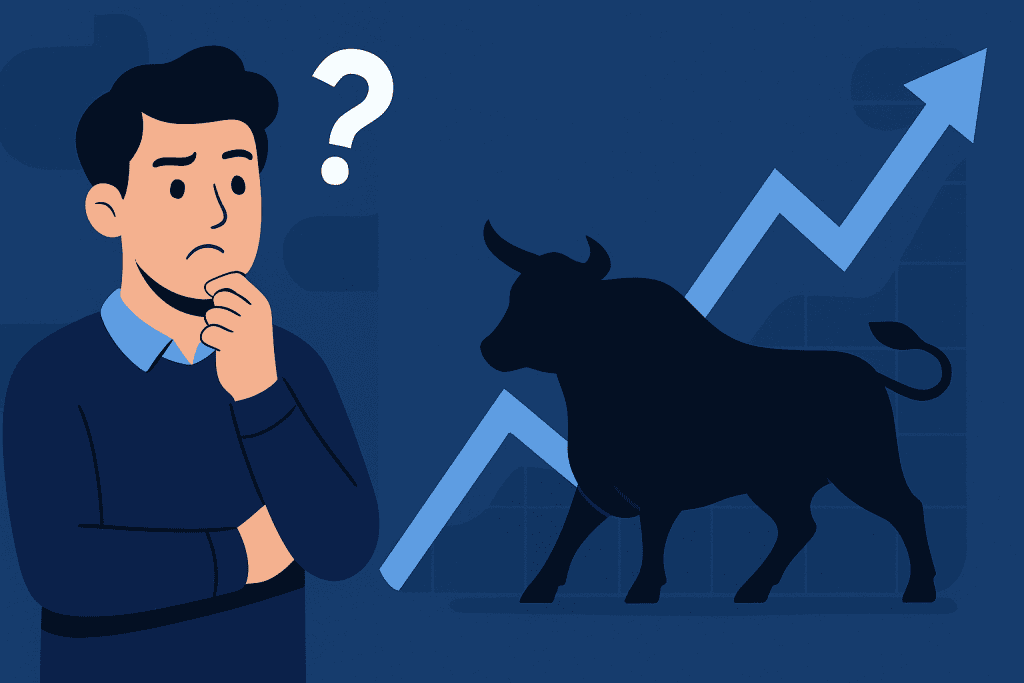If you’ve been dabbling in the Crypto Market or even just scrolling through financial news, you’ve probably heard the term Bull Market tossed around like confetti. But what exactly does it mean—and why does it get investors so excited? Simply put, It is a period when prices rise consistently, optimism runs high, and money flows fast. It’s the financial world’s version of a winning streak. In cryptocurrency, where volatility is the norm, knowing when a Bull Market hits can be the difference between smart gains and missed chances. Understanding how it works, where it comes from, and what you can do during one isn’t just helpful—it’s essential. Let’s break it down in a way that actually makes sense (no finance degree needed).
What is Bull Market

A Bull Market refers to a sustained period where asset prices—especially stocks or cryptocurrencies—rise sharply and steadily. You’ll see it used in contrast with a “bear market,” where prices fall. Think of bulls charging forward with power and aggression—that’s exactly the kind of energy a Bull Market brings to the financial world. In crypto, this can mean Bitcoin suddenly hitting new highs or altcoins exploding in value. People are buying, enthusiasm is high, and belief in the market’s strength is contagious.
Other terms you might hear that relate include “bullish trend” or “market upswing.” They all capture the same vibe: growth, confidence, and excitement.
Breaking Down Bull Market
So what exactly makes a Bull Market… bullish?
First, there’s investor confidence. People believe prices will keep rising, so they buy in. More buying drives prices up, which encourages even more buying. It’s a feedback loop of optimism.
Then, there’s strong economic indicators. You’ll often see these fueled by positive earnings reports, government stimulus, or advances in industries like Blockchain. These factors give people a reason to think, “Hey, maybe it’s a good time to invest.”
Another critical component is demand outpacing supply. In crypto, for example, if there are only so many coins available and everyone wants in, prices naturally shoot up. Even casual investors get FOMO (fear of missing out) and jump in—further driving the surge.
Here’s a personal example. Back in 2020, during the COVID-19 recovery, I watched the Coin Market skyrocket. Friends who’d never owned crypto were suddenly trading daily. Twitter was on fire with people posting charts and rocket emojis. It was wild—but that’s the energy a Bull Market brings. And yes, I bought a little too late (lesson learned).
To sum it up, This thrives on confidence, growth, and momentum. Prices rise because people believe they will. That belief becomes reality—until it doesn’t. (But that’s a bear story.)
History
The term “Bull Market” has been around for centuries. It’s believed to come from the way a bull attacks—thrusting its horns upward, symbolizing rising prices. While the term predates crypto by a long shot, its meaning fits perfectly in today’s fast-paced digital economy.
| Year | Highlights |
|---|---|
| 1990s | Tech stocks soared during the dot-com boom. |
| 2009 | Post-recession recovery sparked the longest bull run in U.S. history. |
| 2017 | Bitcoin and major cryptocurrencies exploded in value. |
| 2020 | COVID-19 recovery triggered a surge in tech and crypto markets. |
| 2021 | NFT and altcoin bull runs dominated headlines. |
Types
Not all Bull Markets are the same. Let’s look at the variations:
Secular
This is a long-term trend, often lasting years. Prices rise over time despite short-term dips.
Cyclical
Shorter-lived than secular ones, these follow economic cycles and last a few months to a few years.
Crypto
Unique to digital assets, this type is fast, volatile, and driven by tech innovation, Investment trends, and social media buzz.
Mini
These happen during a larger bear phase—short bursts of optimism and price hikes that quickly fade.
| Type | Description |
|---|---|
| Secular Bull Market | Long-term growth spanning years or decades. |
| Cyclical Bull Market | Medium-term rise aligned with economic cycles. |
| Crypto Bull Market | Fast-paced and driven by Crypto Market sentiment. |
| Mini Bull Market | Short bursts of upward price action within broader downtrends. |
How does Bull Market work?
In a Bull Market, prices rise due to high demand and strong market sentiment. Investors buy because they expect future gains. That buying pressure pushes prices up even more. News stories, social media, and community hype add fuel to the fire. Technical indicators often show upward momentum, and trading volumes spike. When people believe the market is going up, their actions make it happen. It’s part psychology, part economics—and it feeds on itself until something shakes confidence or profit-taking slows things down.
Pros & Cons
A Bull Market can be a thrilling ride—but it’s not without risk. Here’s a quick look:
| Pros | Cons |
|---|---|
| High potential for gains | Overconfidence can cause bubbles |
| Encourages economic activity | Can lead to poor financial habits |
| Easier access to capital | Corrections can be sudden |
| Boosts investor morale | Newbies may buy at the peak |
Uses of Bull Market

A Bull Market isn’t just a term—it’s a signal. It tells investors, analysts, and even governments how the financial world is moving.
Crypto Trading Strategies
Traders often rely on Bull Markets to execute swing trades, scalp profits, or hold long-term positions. It’s when many fortunes are made—if timed right.
Portfolio Growth
Long-term investors use Bull Markets to grow retirement funds, increase asset value, and diversify holdings across rising sectors like Bitcoin and altcoins.
ICOs and Launchpads
In a Bull Market, Initial Coin Offerings (ICOs) thrive. New tokens and platforms emerge, drawing massive attention and funding.
Institutional Investment
Big players—banks, hedge funds, even governments—often enter during Bull Markets. Their involvement adds legitimacy and liquidity.
During the 2021 crypto, for example, major firms like Tesla and Square bought into Bitcoin, pushing prices and confidence even higher. That kind of momentum fuels wider adoption and opens doors for innovation and mass entry. Bull Markets, especially in crypto, are more than just a trend—they’re a signal of something bigger brewing.
Resources
- Finbold. Guide
- Vantage Markets. Academy
- Finance Strategists. Definition
- Quadra Wealth. What Does it Mean?
- Finance Charts. Definition
